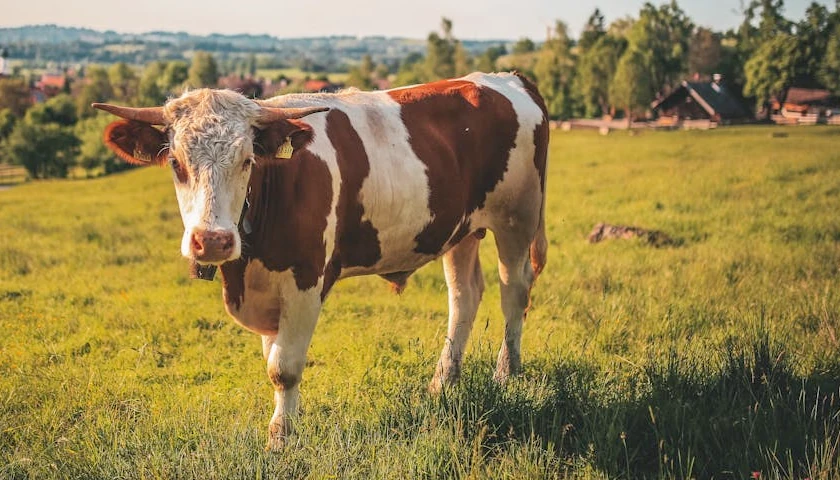by Walker Larson
“Three acres and a cow” became a slogan for those who promoted small landholdings in 1880s England. It was thought to represent an ideal setup for the average family. As it happens, I’ve somehow ended up with exactly that: three acres and a cow—specifically, a Jersey-Fleckvie mix gifted to us by my wife’s dairy-farming family.
The cow is an emblem of an age-old form of true civilization, where men tame the wild without destroying it. The grassland is fenced off, given a shape, form, and purpose, and the animal lives quite a comfortable life, except perhaps for its last day, in which it, too, serves a higher purpose.
The good husbandman works with nature, using what is natural for the cow (a healthy grass diet) for the support of human life and, ultimately, civilization. The cultivation of flourishing human life—with art, and family, and learning, and love, and all of it—begins with the cultivation of plants and animals, which form the bedrock of our existence. Keeping a cow connects you to this venerable tradition.
Keeping a cow also resonates in a father and husband’s heart in a peculiar way. It is in a man’s nature, particularly a married man, to provide for his family. And knowing I have a quadruped source of large quantities of food right outside my door fulfills that natural inclination in a distinctive way.
My office of provider becomes more tangible in the care of the cow than it does when I merely accumulate ephemeral digits representing digital money in my bank account (though that feels all right, too). When I give my family healthful milk raised on our own small acreage, there just aren’t many feelings to compare.
It’s not hard to understand why wealth was once measured in livestock: Here you have a living store of food, drink, clothing, and medicine—something of immense practical value. Most of us have grown far removed from the sources of our food and clothing. Owning a cow reminds us of our dependence upon animal and plant life and, ultimately, the invisible, microscopic empires of microbial life in our soil that make the grass grow.
The cow’s life is built upon the life of the microbes and of the plants, and an animal life, though far below human life in value, of course, is still a remarkable thing to possess. Most cultures throughout time have recognized the intrinsic worth of life, even in animal form, which accounts for the prevalence of animal worship and animal sacrifice throughout history.
More remarkable still, this life can engender other life. My wife informs me that the birth of a calf is one of the greatest joys of keeping a cow, though I have yet to witness this firsthand. Unlike any machines or tools, cows are an asset that reproduce themselves, a characteristic at once highly practical and intensely poetic.
Caring for a cow and seeing it meander my little pasture also fulfills some kind of mysterious need for order. There are certain sights that are beautiful just because we witness something—or someone—doing what they were made to do. It’s like this when you watch a bird swerve in mid-air and alight on a thin branch with perfect precision; a great athlete moving with grace, all muscles coinciding into a single powerful force; or a master craftsman, whose tools flicker deftly in his hand, an extension of his own being. I think watching a cow graze is one of those sights. The cows fulfills its telos, its end, which is to eat grass. And this is order.
You might say there’s nothing particularly remarkable about this bovine activity of munching greenery. And yet, isn’t there something miraculous about a creature with multiple stomachs who can turn grass into thick slabs of meat and golden, cream-frothed milk? This is agricultural alchemy.
As John Donne observed in an Easter sermon in 1627, “There is nothing that God hath established in a constant course of nature, and which therefore is done every day, but would seem a Miracle, and exercise our admiration, if it were done but once.” So it is with the grass-to-meat conversion process that roams my land on four legs. We fail to see the miracle only because it happens all around us and we are familiar with it.
I am not even remotely a cow expert, and my observations here are more poetic than practical. I know little about bovine illnesses, and I have to rely more than I care to admit on my father-in-law (a dairyman of many years) when it comes to questions of breeding, health, and the like. But I can appreciate the slow grace of this lumbering animal as she approaches me, cranes her neck over the fence panels, lets her gentle breath brush my hand, peers at me with wide, wondering eyes, and licks my hand with a tongue covered in tiny bristles for easily tearing up grass.
At other times, above the tall, waving, feathered fingers of the brome grass and orchard grass of the pasture, I see from a distance the flick of a cow’s tail. Ribbons of cloud score the banner of the sky that always feels big up here, on the hillside of the coulee behind my house. I can see the contours of the valley roll gently away from me toward another, larger valley, where the color of the hills fades and grows muted, like an old photograph. And the brown back of the animal moves placidly through the sea of hazel and green, head buried in the goodness the earth provides. She fits right into that landscape.
Peace like this is hard to find, and worth striving for. So I keep a cow.
– – –
Walker Larson holds a BA in writing and an MA in English literature. Prior to becoming a writer, he taught literature and history at a private academy in Wisconsin. He is the author of two novels, Hologram and Song of Spheres. When not working on his acreage or spending time with family and friends, he blogs about literature and education on his Substack, The Hazelnut.





